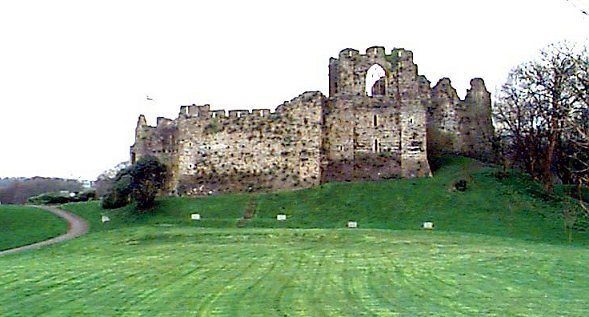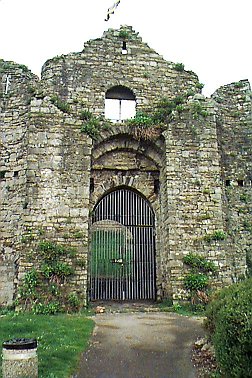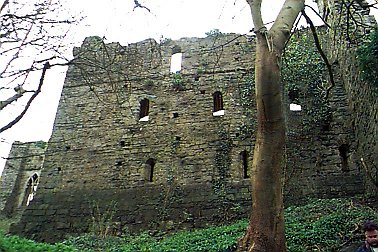Oystermouth

-
- Oystermouth
castle is set towards the SE extremity of the Gower. In the
Middle Ages the lordship of Gower did not consist solely of this
peninsula, but had a deep hinterland spreading northwards into the
highlands of Glamorgan towards Brycheiniog. To the west this
hinterland
was bordered by Carnwyllion, itself a fragment of the commote of
Cedweli; to the north by Cantref Bychan and Cantref Mawr; and to the
east by the sub-lordship of Neath. Commanding the estuary of
the main
river, the Tawe, lay the caput of the lordship, Swansea. As
with so
many castles the references to Oystermouth in the Middle Ages are not
legion. It will therefore be necessary to study the lordship of Gower
and its lords in their entirety and from this history gain a more
rounded picture of the development of this visually pleasing 'castle'.
 The
Gower peninsula in which Oystermouth castle stands was possibly overrun
by the
Earl Henry Beaumont of Warwick (d.1119) at about the same time as King
William I overran Glamorgan
and St Davids
in his campaign of 1081. If any castle was built in the
province at
this time it
would probably have been Swansea. Whatever the case Norman
rule of the
cantref
seems to have been disrupted during the great Welsh rebellion of
1093-99. King
Henry I in trying to stabilise South Wales granted Gower and
the bulk of
Deheubarth to Prince Hywel ap Goronwy
of Rhwng
Gwy a Hafren in 1102. In 1106 Hywel was killed and Gower was
re-occupied by
Earl Henry of Warwick. It was probably around this time that Oystermouth
was granted
to William London (d.bef.1128),
the mesne lord of Ogmore in
Glamorgan. William built a castle at Oystermouth in this period only to
have it
destroyed by Prince Gruffydd ap Rhys of Deheubarth in 1116.
It is
interesting to
see that the Welsh chronicle describes William as ‘abandoning
his castle,
cattle and men' and fleeing towards England. Possibly, after
the
burning of
Swansea, William took ship to his land of Ogmore
just across the bay,
therefore
‘abandoning’ his men and property.
However, it
should be noted that standard
practise was not for a lord to get bottled up in a besieged castle, but
to leave
a strong garrison in place while he went off to raise a relief army.
The Welsh
chronicle often overplayed Welsh military prowess and scorned Norman
efforts.
Such literary works of a lesser power engaged in warfare against a
stronger
power have done nothing less since the days of Judea.
The
Gower peninsula in which Oystermouth castle stands was possibly overrun
by the
Earl Henry Beaumont of Warwick (d.1119) at about the same time as King
William I overran Glamorgan
and St Davids
in his campaign of 1081. If any castle was built in the
province at
this time it
would probably have been Swansea. Whatever the case Norman
rule of the
cantref
seems to have been disrupted during the great Welsh rebellion of
1093-99. King
Henry I in trying to stabilise South Wales granted Gower and
the bulk of
Deheubarth to Prince Hywel ap Goronwy
of Rhwng
Gwy a Hafren in 1102. In 1106 Hywel was killed and Gower was
re-occupied by
Earl Henry of Warwick. It was probably around this time that Oystermouth
was granted
to William London (d.bef.1128),
the mesne lord of Ogmore in
Glamorgan. William built a castle at Oystermouth in this period only to
have it
destroyed by Prince Gruffydd ap Rhys of Deheubarth in 1116.
It is
interesting to
see that the Welsh chronicle describes William as ‘abandoning
his castle,
cattle and men' and fleeing towards England. Possibly, after
the
burning of
Swansea, William took ship to his land of Ogmore
just across the bay,
therefore
‘abandoning’ his men and property.
However, it
should be noted that standard
practise was not for a lord to get bottled up in a besieged castle, but
to leave
a strong garrison in place while he went off to raise a relief army.
The Welsh
chronicle often overplayed Welsh military prowess and scorned Norman
efforts.
Such literary works of a lesser power engaged in warfare against a
stronger
power have done nothing less since the days of Judea.
What is
certain is that William returned and
rebuilt his castle. It was probably his son Maurice London
(d.1162) who had to
face the
next Welsh crisis when Hywel ap Maredudd of Brycheiniog overwhelmed the
defences
of Gower once more in January 1136. In 1141 Maurice upgraded his
father’s
foundation of Ewenny near Ogmore into a priory before being laid to
rest there
under a fine tomb around 1162.
Maurice’s
grandsons, William (d.1212) and Thomas (d.1215), were
instrumental in holding the power of Prince Llywelyn ab Iorwerth at bay
during
the reign of King
John
(1199-1216). It is perhaps fitting that no more is heard of Thomas, the
last
London lord of Oystermouth, after the Welsh stormed the Gower peninsula
in 1215
and sacked Oystermouth castle. No mention, however, is made
of his
death. With
the death of the last male London and the overrunning of Gower,
Oystermouth was
given by Prince Llywelyn to Rhys Gryg of Deheubarth. In 1220
Llywelyn
ousted
Rhys and granted Gower to John Braose (d.1232), the son of William
Braose Junior, starved to death by King John. It
would seem
likely that John
rebuilt Oystermouth as well as Swansea
castle. The castle then passed
down the
Braose family until it passed to the Mowbrays and then back to the
earls of
Warwick in the mid fourteenth century.
 The
castle consists of a great keep and hall block of the twelfth century
set upon
an earlier ringwork of which only half was apparently defended in
stone. In the
thirteenth century a great twin towered gatehouse was added, of which
the two
towers have subsequently been demolished giving Oystermouth its unique
and
picturesque frontage. If the towers had survived they would
have put Oystermouth in the class of twin towered gatehouse that exist
elsewhere in Wales
at Caerphilly, Carmarthen, Chepstow, Criccieth, Degannwy, Dinas Bran,
Llawhaden, Neath,
Powis, Rhuddlan, Tinboeth and White Castle.
In England examples survive at
Beeston, Bungay, Clifford,
Dover, Longtown, Pembridge, St Briavels, the
Tower of London
and Whittington.
In
Scotland they can be found at Kildrummy
and Urquhart
and finally elsewhere in Ireland at Carrickfergus,
Castle Roche, Limerick and Roscommon.
The
castle consists of a great keep and hall block of the twelfth century
set upon
an earlier ringwork of which only half was apparently defended in
stone. In the
thirteenth century a great twin towered gatehouse was added, of which
the two
towers have subsequently been demolished giving Oystermouth its unique
and
picturesque frontage. If the towers had survived they would
have put Oystermouth in the class of twin towered gatehouse that exist
elsewhere in Wales
at Caerphilly, Carmarthen, Chepstow, Criccieth, Degannwy, Dinas Bran,
Llawhaden, Neath,
Powis, Rhuddlan, Tinboeth and White Castle.
In England examples survive at
Beeston, Bungay, Clifford,
Dover, Longtown, Pembridge, St Briavels, the
Tower of London
and Whittington.
In
Scotland they can be found at Kildrummy
and Urquhart
and finally elsewhere in Ireland at Carrickfergus,
Castle Roche, Limerick and Roscommon.
The keep was raised in height
in the fourteenth
century
with a chapel being placed on top. The interior of the castle
is still
crowed
with many halls, solars, barracks and apartments. The castle
was
restored in the
Victorian era by the earl of Cawdor who also refurbished Castell
Carreg Cennen. In both castles a few
‘interesting’ additions were made
Order Oystermouth Castle
through the PayPal basket below.
Copyright©1994-2004
Paul Martin Remfry


